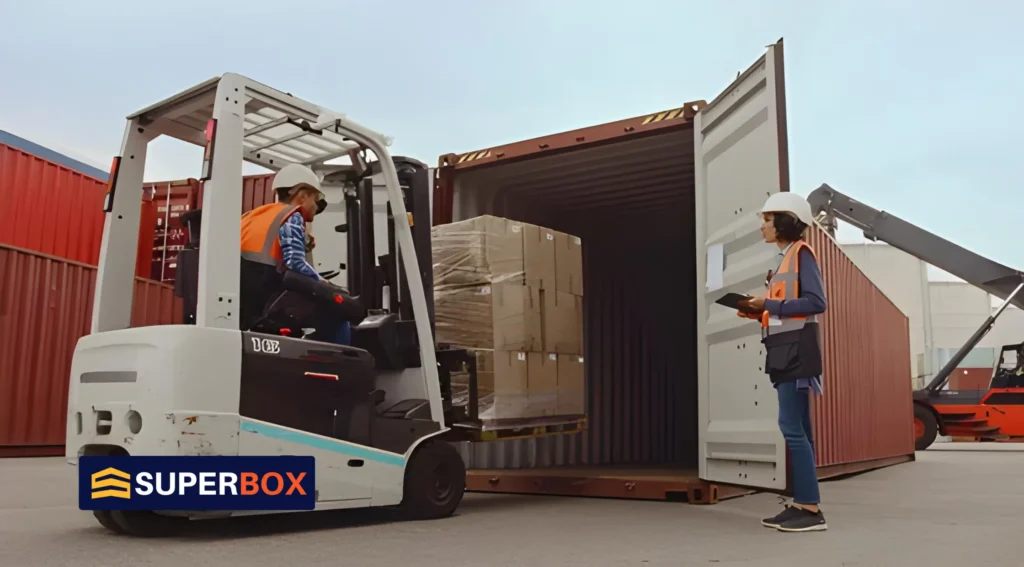Shipping containers are the backbone of international trade, helping transport goods across the globe. But while they are designed to be sturdy and secure, it’s the proper loading and unloading process that ensures goods arrive safely and in good condition. Whether you’re in a warehouse, port, or distribution center, knowing how to load and unload a shipping container correctly is key to minimizing risk and maximizing efficiency. In this blog post, we’ll walk through the process, safety considerations, and equipment involved in loading and unloading shipping containers.

Understanding the Basics of Shipping Containers
Shipping containers are large, standardized boxes used to transport goods by sea, land, or air. They come in various sizes (most commonly 20 feet or 40 feet long) and types, including standard containers, refrigerated containers, and even those designed for hazardous materials. No matter the type of container, the loading and unloading process must be handled carefully to protect both the cargo and the workers involved.
Why is proper loading and unloading so important? If not done correctly, goods can become damaged, containers may get overloaded or unbalanced, and there are increased risks of accidents. Ensuring that each container is loaded properly can also save time and reduce unnecessary delays when unloading.

How to Load and Unload a Shipping Container
Here’s a simple guide to help you safely and efficiently load and unload a shipping container.

The Loading Process
- Prepare the Container: Before you start loading, always inspect the container for any visible damage, such as rust or dents. A container in poor condition may not be safe for use. It’s also important to make sure the container is clean and free from any debris that could damage the goods.

- Load the Items Correctly: Start by placing heavier items at the bottom when loading a shipping container. This creates a stable base and reduces the chance of the load shifting during transport. Use the available space wisely by stacking boxes and items tightly, but make sure not to overload one side or one area of the container to keep it balanced.

- Securing the Load: Once everything is loaded, you must secure the items. Use straps, shrink wrap, or dunnage to prevent goods from shifting during transit. For hazardous materials, ensure you’re following all safety regulations regarding securement.
The Unloading Process

- Prepare the Area: Before unloading, create a safe unloading zone. This space should be free of obstacles, and heavy-duty equipment like forklifts, side loaders, or reach stackers should be available. If you’re unloading hazardous materials, ensure the proper tools and safety measures are in place.

- Unload in Reverse Order: The unloading process is usually the reverse of loading. Start by removing the lightest items first, and work toward the heavier items. Always check the condition of each item as you unload to ensure nothing is damaged during transit.

- Handle Hazardous Materials Safely: If you’re unloading hazardous materials, such as chemicals or flammable goods, it’s crucial to follow all safety protocols. Always use the right equipment and PPE, and ensure workers are trained in handling hazardous materials.
The Equipment Used in Loading and Unloading Shipping Containers
The right equipment is crucial for efficiently loading and unloading shipping containers, especially when handling heavy loads or working in tight spaces. Here are two key types of machinery commonly used in container operations.

Side Loaders
Side loaders are specialized equipment used to load and unload shipping containers from the side. They are especially useful in areas where there is limited space or when containers need to be stacked. Side loaders can move containers from one location to another with precision and are often used in ports or rail yards.

Reach Stackers
Reach stackers are heavy-duty equipment designed for lifting and stacking containers in tight spaces. They can handle multiple containers at once, making them ideal for heavy-duty unloading operations. Reach stackers are typically used in ports where large numbers of containers need to be unloaded quickly and efficiently.
Safety Considerations When Loading and Unloading Shipping Containers
Safety is extremely important when working with shipping containers. Taking the right precautions can protect both the workers and the goods being transported. Here’s how to make sure you stay safe at every step of the loading and unloading process:
Personal Safety:
Always wear the proper personal protective equipment (PPE) to keep yourself safe. This includes items like gloves, safety boots, and helmets to protect from injuries. In addition to wearing PPE, it’s important that workers are trained in safe lifting techniques and how to handle heavy or awkward loads. This helps prevent accidents and makes sure that everyone knows how to lift and move things properly.
Common Hazards:
There are several dangers to watch out for when loading and unloading shipping containers. One of the biggest risks is falling items, especially if the load inside the container is not packed properly or is unbalanced. If boxes or heavy items are stacked too high or not secured, they could fall and hurt someone. If you’re dealing with hazardous materials—like chemicals, flammable goods, or corrosive substances—it’s even more important to follow strict safety rules. These materials need to be handled carefully, and workers must know how to dispose of them properly to avoid accidents or spills.
Ensure Containers Are in Good Condition:
Before you start loading or unloading a shipping container, it’s essential to check the container itself for any damage. Look for signs of rust, holes, leaks, or any cracks that could weaken the container. If a container is damaged, it could break during handling or transport, causing harm to the workers and damaging the goods inside. Ensuring the container is in good condition helps prevent these risks and keeps the operation running smoothly.
Best Practices for Efficient Loading and Unloading
Efficiency is just as important as safety. Here are some tips for improving both:
- Pre-planning: Before you start loading or unloading, plan the process carefully. This includes organizing the items in the right order and ensuring the right equipment is available.
- Use of Technology: Technology can help track containers, monitor cargo, and even automate parts of the process. Many logistics companies use digital tools for container management, improving efficiency and accuracy.
- Teamwork: Loading and unloading containers is often a team effort. Clear communication between workers ensures that everything runs smoothly and safely.
Conclusion
Properly loading and unloading shipping containers is critical to ensuring goods arrive safely and on time. By following the right techniques, using the right equipment, and maintaining a focus on safety, you can make the process more efficient and minimize risks. Whether you’re working with hazardous materials or standard goods, attention to detail is essential. So, whether you’re loading or unloading, always make sure you’re following the best practices for a job well done.
Efficiently Load and Unload Shipping Containers with SuperBox
At SuperBox, we provide top-quality shipping containers designed to meet all your shipping and storage needs. Whether you’re moving large equipment, fragile goods, or perishable items, the key to a successful shipping process is knowing how to load and unload your containers properly.
Our standardized shipping containers come in various sizes, including 20-foot and 40-foot options, and we also offer refrigerated units to keep temperature-sensitive goods secure during transit. To make loading and unloading even easier, we offer shipping container ramps that help you safely roll heavy items into or out of the container, reducing the risk of injury or damage.
Our goal is to ensure customer satisfaction every step of the way. Need advice on the right container or ramp for your needs? Call 1-866-696-9269 today, and let SuperBox assist you in making your shipping process safe, efficient, and hassle-free!





